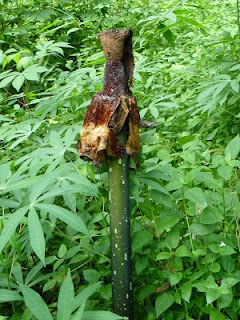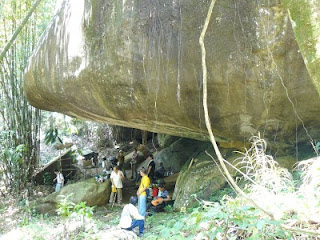NATURALLY STUNNING: The limestone cliffs from Camp 5.
By Mary Margaret
MULU National Park is striking. From the air, the massive 2,376-metre Gunung Mulu dominates the southeastern part of the park and the spectacular line of limestone mountains, which includes Gunung Api — the pinnacles — the northwestern. However, to experience the park at its best, one has to go to the ground. This ecologically diverse 544 square km park is rightfully a United Nations Educational, Scientific and Cultural Organisation (Unesco) World Heritage Site. The range of ecological niches corresponds to the diversity in the plant and animal world. Recently, I got up close to Mulu National Park when I hiked the Headhunters Trail with some friends. According to lore, Kayan headhunting parties travelled up the Limbang River, into the Terikan River before portaging across the watershed and Melinau Gorge to enter the Baram watershed via the Melinau River.
The journey, for modern- day travellers, generally starts from the park headquarters with a two- hour longboat ride up therather shallow Melinau River, which marks the park boundary until its tributary, the Lutut.Large trees shaded the river as we progressed, and near the entrance of the famed Clearwater Cave, limestone cliffs overshadowed us. At Long Lutut, we started walking. Signs of man — past and present — were apparent. There was the occasional bit of plastic, but mostly the forest told stories of human activity.The trees in this lowland, predominantly secondary riverine forest, were generally small and composed of pioneer species, in addition to large clumps of bamboo. However, a few large emergents, including the towering tapang (Koompassia excelsa), as it is known in Sarawak or tualang in other parts of Malaysia, remain.Tapang, a member of the legume family, the sixth largest tree in the world, can reach up to 250 feet (about 75 metres) as it emerges above the canopy and is supported on enormous buttressed roots. Giant honeybees build huge combsin these trees. According to traditional beliefs, spirits protects these trees and it is a taboo to cut them.
The trail is flat, but occasionally walkers get a sense of the immensity of Gunung Api as it looms above. In 1929, a fire on Gunung Api could be seen as far away as Brunei. Camp 5 is the staging point for those going on to the Headhunters Trail and those heading up to the Pinnacles. The camp has historical origins — members of the Oxford Expedition established it in the late 1980s. During this time, scientists from around the world explored the mysteries of Mulu.
The next day starts with crossing the Melinau River on a long swing suspension bridge that is securely held at either end. The water swirls and tumbles down the gorge.The forest feels different along this part of the trail; it is older and the trees arelarger. It is also darker and cooler; light plays on the ground plants in unexpected and surprising ways. At times rocks on either side shroud the trail.
We saw places where rivers disappeared into the mountain and mini- limestone pinnacles that had been created by the slightly acidic rainwater eroding away the limestone. But disturbingly many old belian (Eusideroxlon malagangai), Borneo ironwood trees, a lowland secondary and primary forest species, have tumbled down, leaving stumps as monuments to their existence. On a positive note, many of the oval seeds had fallen along the trail; with time seedlings will sprout and, hopefully, grow into the canopy.The wood of this slow growing canopy species is heavy and durable but easily worked, and is used in, for example, construction of longhouses, marine construction, tools and furniture.
Gradually the trail veers away from Gunung Api as it crosses into the Limbang River watershed marked only by a slight climb. At Batu Rikan (Rikan Rock) the trail crosses the Terikan River on a slender but strong rope bridge thats ways with the slightest and lightest step.
VERY GREEN: The play of light on the forest floor.
The trail skirts the Terikan River as it goes through the damp forest until reaching the Medalam River a tributary of the Limbang River. From there we took a longboat to Kampung Medalam to overnight before journeying on to Limbang. The Medalam River tunnelled through the forest as the canopy practically touched from the riverbanks. The water was shallow and the longboat had to aim for the deeper channels taking on sharp curves. The startling blue, red- billed black-capped kingfisher, a migrant, darted along the riverbank in search of prey, as did egrets. The highlight was the unexpected take off of a darter. Enkabang (Shorea macrophylla) a mediumsized tree was fruiting heavily and many of the residents of Kampung Medalam were collecting and partially processing the large, easily recognisable winged seeds. According to them this was the first sizeable fruiting season in over 20 years. This mass fruiting phenomena has occurred in many parts of the state. Enkabang, one of the 200 Shorea species, a member of the Dipterocarpaceae family, is a relatively fast growing member of this family.
It is sometimes cultivated because of its valuable seed that produces oil used in skin care products and as a substitute for cocoa butter in fine quality chocolate. And so our trip ended — we had walked the historic Headhunters Trail and were fortunate to observe a time- honoured tradition of collecting and processing Enkabang seeds.





















































